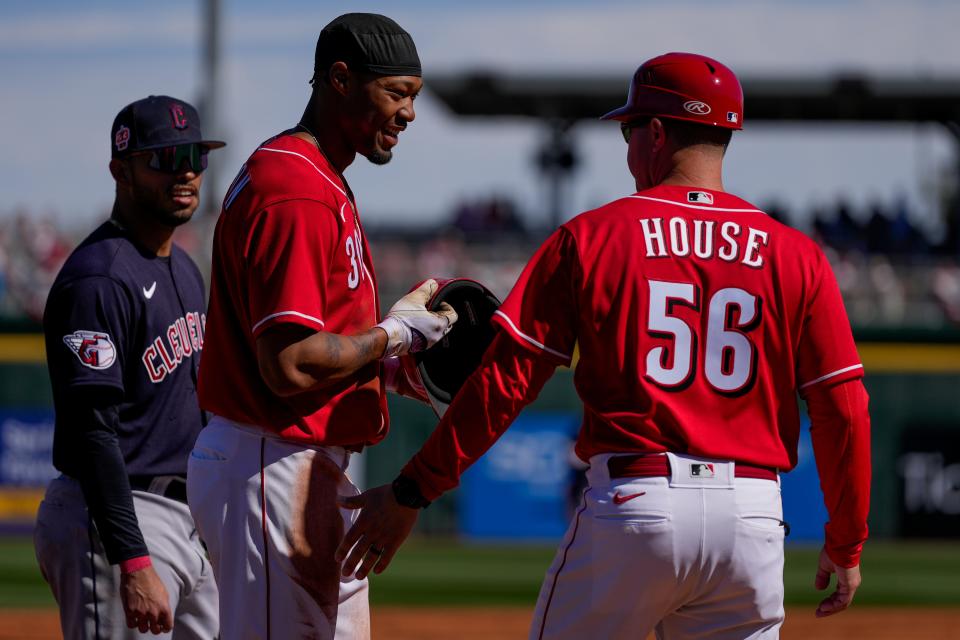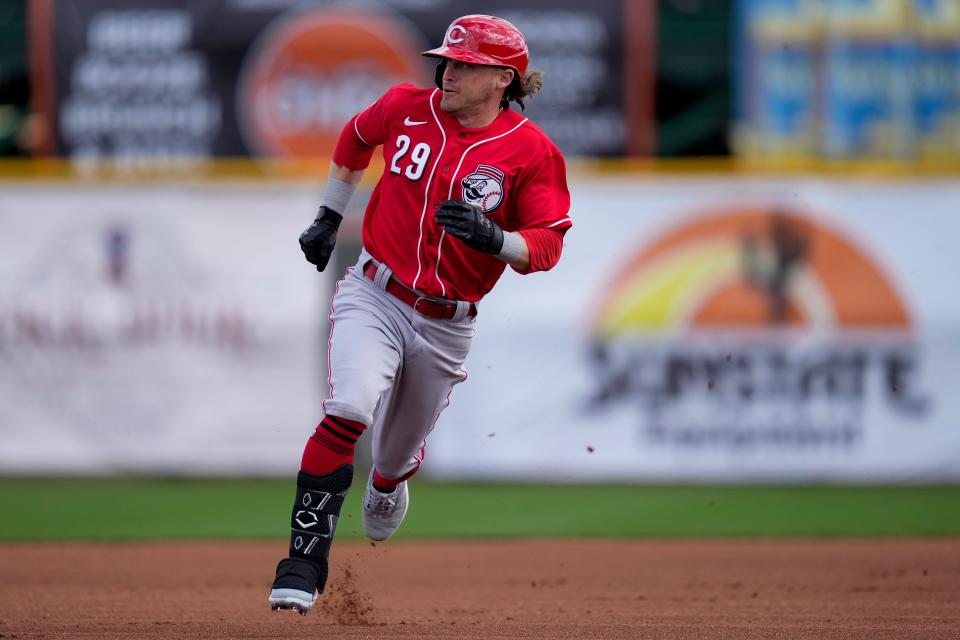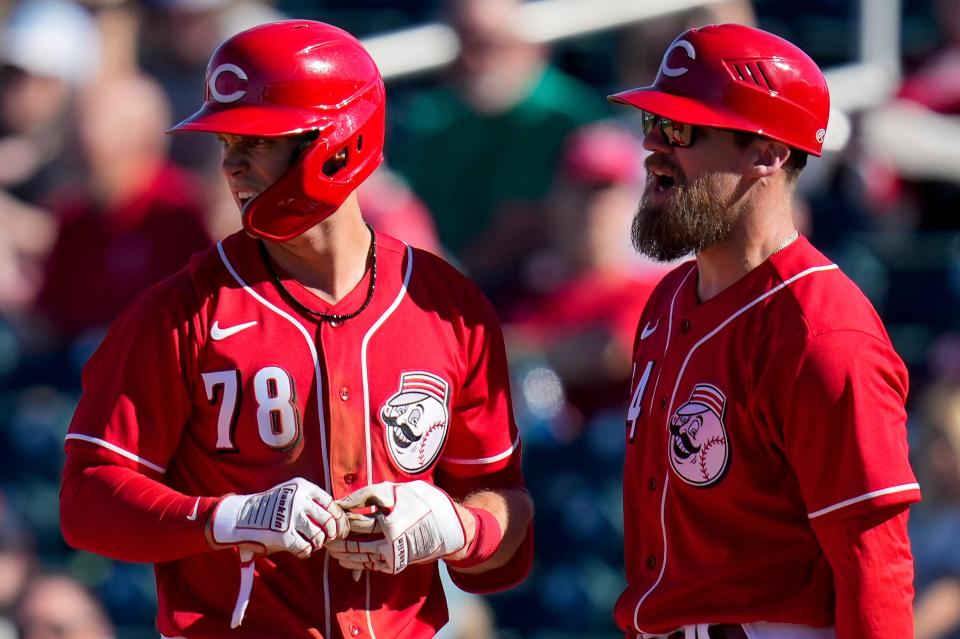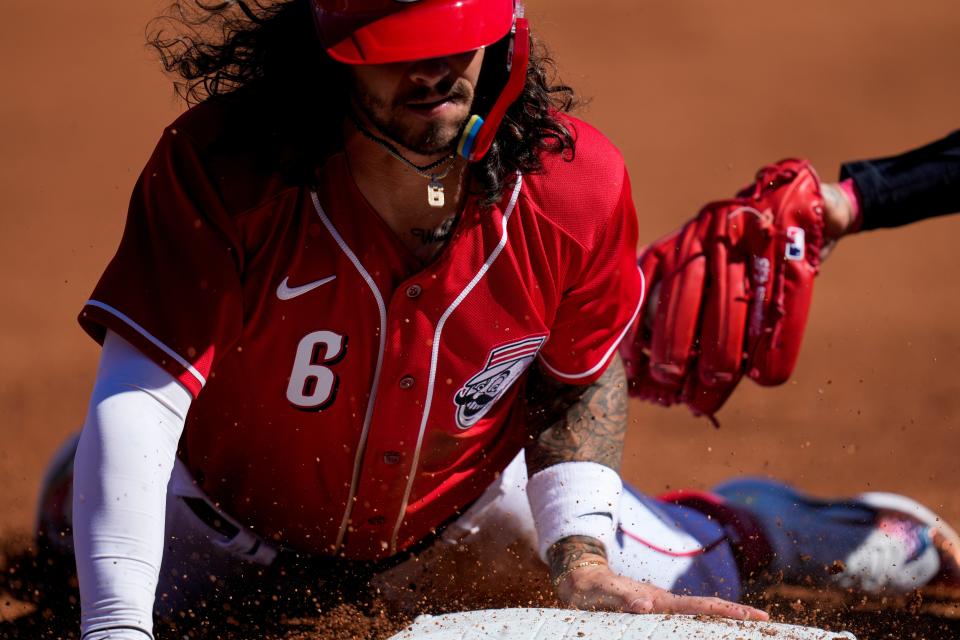'That's our strength': The Reds expect MLB's new rules to benefit them on the basepaths
GOODYEAR, Ariz. – There will be several new rules carried into regular season games next week, notably the pitch clock and restrictions on defensive shifts, and the Cincinnati Reds believe it’ll help turn one of their weaknesses into a strength.
There should be more singles, particularly for lefthanded hitters, without the shifts. Part of the pitch clock is allotting pitchers a maximum of two pickoff attempts. If a third pickoff attempt is unsuccessful, it’s ruled a balk. Even the bases are a little bigger, slightly trimming the distance between bags.
How could it benefit the Reds?

Expect a more aggressive team on the basepaths. Use an eight-run rally during Monday’s spring training game as an example. Jake Fraley scored easily from second on a bloop single to center. Spencer Steer took an extra base on a double down the left field line, moving up on an errant throw to the cutoff man. Jonathan India advanced to second on a throw after his groundball single, stole third and scored on a single.
Reds spring trainingReds' Nick Senzel returns to spring training games as he completes injury comeback
Reds opening dayReds game observations: Graham Ashcraft leaves lasting impression in final spring start
Reds spring training'That’s just who they are': Cincinnati Reds encouraged by prospects throughout spring
“I think it’s pretty obvious we’re not going to be a heavy homer-hitting team, but there are so many more ways to manufacture runs than just by hitting home runs,” Reds outfielder TJ Friedl said. “Ball in the dirt and taking the extra base, first to third on a base hit, little things like that will add up to runs. That’s how we’re going to make an impact on the bases because we’re young, we’re athletic, we have a bunch of fast guys. That’s our strength.”
The Reds were terrible on the basepaths last year. They ranked 24th in the majors in stolen bases (58) and sixth in caught stealing (33), a 63.7% success rate, which was the worst in the league.
There were 12 teams caught stealing 30 times last season and the Reds were one of two teams (Toronto) with fewer than 75 stolen bases in that group. The Reds rated as the third-worst baserunning team, according to FanGraphs’ baserunning metric. They ranked last in moving first-to-third on a single, according to Baseball-Reference.

The Reds’ roster is more equipped to take extra bases, stealing 36 bases in 42 attempts this spring. Will Benson and Nick Senzel have elite speed while Friedl, India and Fraley bring above-average speed.
“I’m starting to experience a little bit of benefit with my leads,” said Benson, who has swiped six bases in seven attempts this spring. “It’s something (first-base coach) Collin Cowgill, he was like ‘looking at what you were doing last year with your leads, you can get a little extra.’ I was like, ‘all right, let me play with it.’ So far this spring, I’ve had the ability to get back with ease and then feel comfortable being more off.”
Reds spring trainingThe Reds are counting on more experience in their 2023 bullpen
Reds player movesLefty pitcher Daniel Norris released, three other players cut from Reds camp
With more speed on the roster and some key rule changes, the Reds see ways to use it to their advantage. There is a big difference between green lights on the bases during spring training and the regular season, but it’s been an emphasis throughout camp.

Runners say it’s difficult to attempt stolen bases by timing the pitch clock, but Cowgill showed statistics about stolen base success rates rising after one pickoff attempt and two pickoff attempts.
“The pitchers who aren’t quick to the plate will really get exposed,” Reds third-base coach J.R. House said. “There has been, throughout the game, the tendency to not steal as much. I think that’s really going to change.”
Said Friedl: “After one pickoff, they are not very likely to pick over. After two, they are almost never likely to pick over. Little things like that, you have an idea of it, but then you see it on a PowerPoint or on paper in front of your face, OK, as a basestealer for me, there are numbers to that, so I can get a little bit more aggressive.”
The restriction on defensive shifts should create more groundball singles. Manager David Bell thinks it’ll be noticeable between the second basemen and second base bag. Without a roving infielder in shallow right field for lefthanded hitters, it creates more first-to-third opportunities on the basepaths.
The balance for House, the third-base coach, is analytics almost always favor sending a runner to the plate. With so many strikeouts and so few hits in recent years, analytical odds greatly preferred overly aggressive waves to the plate compared to seeing if the next batter could drive the runner in.
“Do we need to be as risky because there will be more balls put in play?” House said. “I think there will be a positive for getting more singles out of that. It could make us a little more hesitant to take some of those chances because there are going to be more singles, so that’ll be interesting to see.”

There will be a cat-and-mouse element to the limited pickoff attempts. Teams will try different things despite the shift restrictions. If there are runners on second and third, with two outs, maybe a team tries a two-man outfield and a five-man infield if the batter is prone to a lot of groundballs.
Reds starting rotationReds game observations: Nick Lodolo's curveball in midseason form during spring win
There is data from how the rule changes affected play in the minor leagues, but the majors are a different testing ground. The Reds, at least throughout the spring, have shown how baserunning could have a big impact on their offense.
“More times than not, you’re safe,” Benson said. “Why not take advantage of it? Out of 10 times, you’re probably going to get thrown out twice. If you have speed, it’s probably cut down to once. Take advantage. You know the guys who have good arms. You know who get to the balls quick. And then you expose people who don’t do that.”
This article originally appeared on Cincinnati Enquirer: Cincinnati Reds expect new MLB rules to benefit them on basepaths

